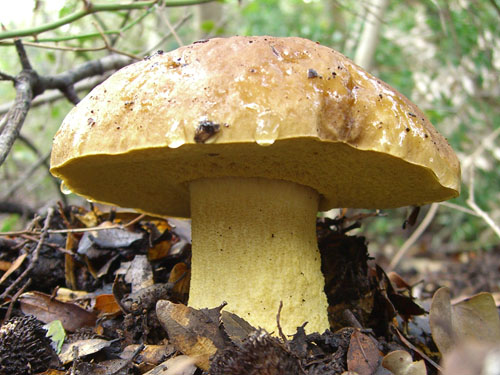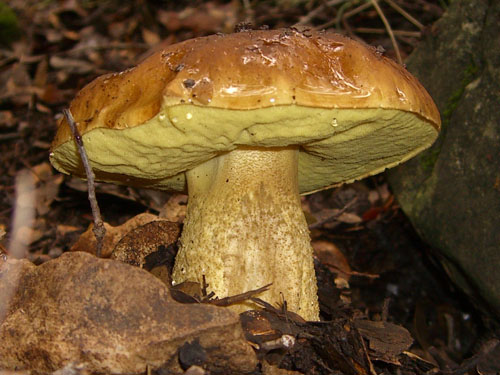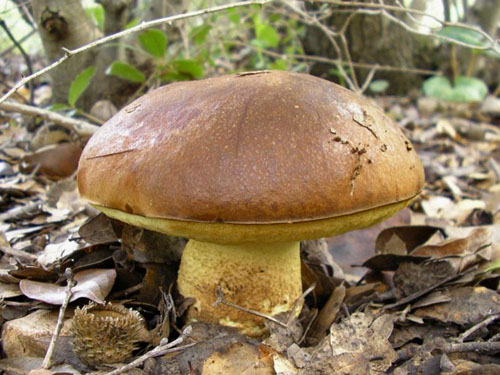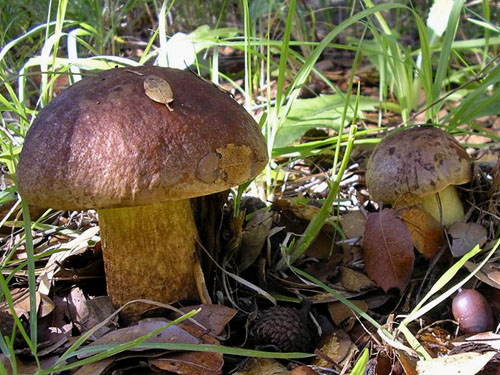Leccinum Gray
Many species are known in Europe, although recent molecular studies have reduced significantly their number. Although the reader will find numerous references bellow, they should always consult the treatment of Den Bakker & Noordeloos (2005), some of its results also partly available online (see Noordeloos, online) in the form of a key, descriptions and photographs. Useful keys (excluding two south European species) are provided also by Kibby (2006) and Knudsen & Vesterholt (2008). Everybody reading those pages have to bear in mind that identification of Leccinum currently relies on both macroscopic and microscopic characters.
Fruitbody boletoid without veil and ring. Stipe solid, covered with numerous squamules. Flesh whitish or yellowish, sometimes spotted blue or greenish in the stipe base, in many species changing dramatically to pinkish, reddish, violaceous grey to black.
Leccinum lepidum (P. Bouchet) Quadr.
Description
Cap up to 12 cm, at first hemispherical, then convex, yellowish brown, ochraceous, orange brown, brown, dark brown to almost blackish, dry, but distinctly viscid in wet weather. Stipe usually stout, ovoid, cylindrical or slightly club-shaped, pale yellow to yellow, often discolouring with age to cream or whitish, covered with yellow to rusty or brown granules. Flesh pale yellow to whitish, changing to pinkish or reddish, and then to violaceous or greyish, when exposed to air. Tubes pale yellow to yellow. Pores concolorous with the tubes, sometimes tinged rusty, darkening to somewhat ochraceous when bruised. Smell not distinctive. Taste not distinctive. Spores 13.5–21 × 5–6 μm. Pileipellis trichodermium of septate hyphae of finely incrusted cylindrical cells.
Habitat. Broadleaf forests, mycorrhizal with evergreen oaks (Quercus coccifera, Q. ilex, Q. suber, Q. faginea).
Distribution. Not yet fully understood, but apparently a southern species, seen so far only in the Mediterranean area – France, Italy, Sardinia, Spain. Outside Europe it is spotted also in Israel, judging from findings of amateur mycologists.
Similarity. Similar to Leccinum crocipodium, but the cap cuticle of the later contains spherical cells that are absent in L. lepidum. Leccinum corsicum is also very similar but it also has spherical cells in the cap cuticle and grows in different habitat, mycorrhizal with rockroses (Cistus).
Photographs

Typical fruitbodies of Leccinum lepidum. (photo Z. Shafranov)

Fruitbody of Leccinum lepidum. Note the cap which becomes viscid in wet weather. (photo R. Kuznetsov)

Fruitbody of Leccinum lepidum. (photo R. Kuznetsov)

Fruitbodies of Leccinum lepidum. (photo Z. Shafranov)

Leccinum lepidum - fruitbody with dark coloured cap. (photo Z. Shafranov)

Leccinum lepidum - fruitbodies with dark coloured caps. (photo Z. Shafranov)
Important literature
Alessio, C.L. 1985. Boletus Dill. ex L. (sensu lato). – In: Fungi Europaei. Vol. 2. Pp. 1–705. Libreria editrice Biella Giovanna, Saronno.
Estadès, A. & Lannoy, G. 2004. Les bolets européens. – Bulletin Mycologique et Botanique Dauphiné-Savoie 44(3): 3–79.
Galli, R. 1998. I Boleti. Atlante pratico-monographico per la determinazione dei boleti. Edinatura, Milano.
Lannoy, G. & Estadès, A. 1995. Monographie des Leccinum d’Europe. Fédération Mycologique Dauphiné-Savoie.
Lannoy, G. & Estadès, A. 2001. Les Bolets. Flore mycologique d’Europe. Documents Mycologiques Mémoire Hors série no. 6. Pp. 1–163. Association d’Écologie et de Mycologie, Lille.
Muñoz, J.A. 2005. Boletus s. l. – In: Fungi Europaei. Vol. 1. Pp. 1–951. Edizioni Candusso, Alassio.
Muñoz Sánchez, J. A. 1996. Algunas consideraciones sobre Leccinum lepidum (Bouchet) Quadraccia, L. crocipodium (Letellier) Watling y L. corsicum (Rolland) Singer. – Belarra 13: 11–18. (available online)